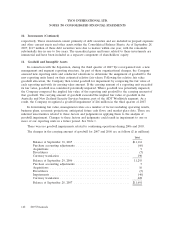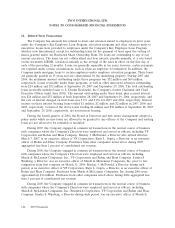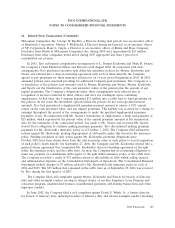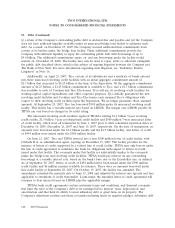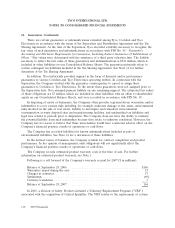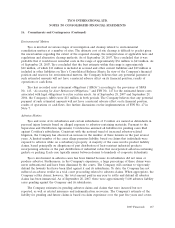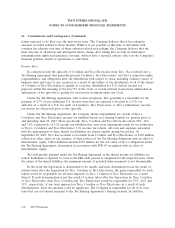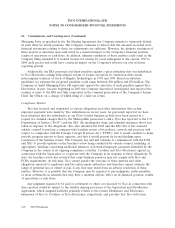ADT 2007 Annual Report Download - page 224
Download and view the complete annual report
Please find page 224 of the 2007 ADT annual report below. You can navigate through the pages in the report by either clicking on the pages listed below, or by using the keyword search tool below to find specific information within the annual report.TYCO INTERNATIONAL LTD.
NOTES TO CONSOLIDATED FINANCIAL STATEMENTS
15. Financial Instruments (Continued)
As part of managing the exposure to changes in foreign currency exchange rates, the Company
utilizes forward and option contracts with financial institutions acting as principal counterparties. The
objective of these derivative contracts is to minimize impacts to cash flows associated with
intercompany loans, notes receivable and accounts payable, and forecasted transactions due to changes
in foreign currency exchange rates.
The Company’s derivative financial instruments present certain market and counterparty risks;
however, concentration of counterparty risk is mitigated as Tyco deals with a variety of major banks
worldwide with long-term Standard & Poor’s and Moody’s credit ratings of A/A2 or higher. In addition,
only conventional derivative financial instruments are utilized, thereby affording optimum clarity as to
the market risk. None of the Company’s derivative financial instruments outstanding at year end would
result in a significant loss to the Company if a counterparty failed to perform according to the terms of
its agreement. At this time, the Company does not require collateral or other security to be furnished
by the counterparties to its derivative financial instruments.
In assessing the current and potential future risk attributable to interest rate movements, during
the fourth quarter of 2006, the Company terminated interest rate swaps and cross currency agreements
with an aggregate notional value of $2.5 billion. The fair value of the swaps at the time of termination
was a net gain of $10 million. As the interest rate swaps were designated as hedging instruments of
outstanding debt, the net deferred loss of $26 million will be recognized in earnings over the remaining
term of the related debt instrument. The remaining agreements were terminated during the first
quarter of 2007.
Interest Rate Exposures
The Company historically utilized interest rate swap agreements to manage its exposure to interest
rate risk. During the first quarter of 2007, the Company terminated the interest rate swaps. Since the
interest rate swaps were designated as hedging instruments of outstanding debt, the related loss will be
amortized over the remaining life of the related debt instruments. Prior to termination, the
mark-to-market effects of both the interest rate swap agreements and the underlying debt obligations
were recorded in interest expense and are directly offsetting to the extent the hedges are effective.
In addition, the Company historically utilized interest rate and foreign currency swap agreements
(‘‘cross currency swaps’’) to manage its exposure to interest rate risk and foreign currency exposure on
loans denominated in foreign currency. During the first quarter of 2007, the Company terminated these
agreements. The settlement of the swaps terminated during the first quarter of 2007 along with
$17 million of swaps in a gain position that were terminated in the fourth quarter of 2006 resulted in a
net cash inflow of $63 million in the first quarter of 2007. In connection with the debt tender offer,
$9 million of unamortized loss on interest rate swaps was accelerated and recorded as a loss on
retirement of debt and included in other expense, net (see Note 13). At September 28, 2007 there were
no cross-currency or interest rate swaps outstanding. Prior to termination, the mark-to-market effects
on the interest rate and foreign currency swaps were recorded in interest expense and selling, general
and administrative expenses, respectively, and directly offset the corresponding changes in the fair value
of the hedged items to the extent the hedges were effective. The ineffective portion of the hedge was
not material.
132 2007 Financials


